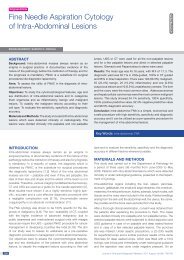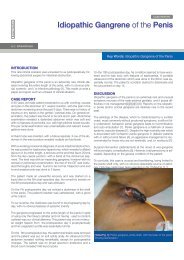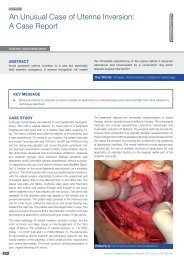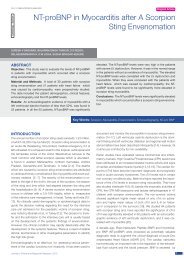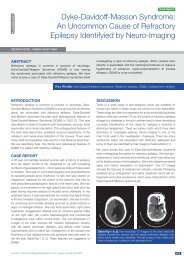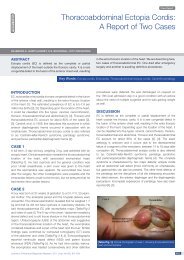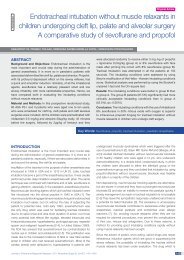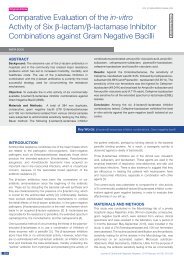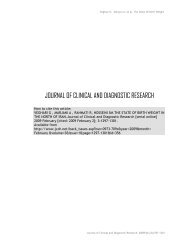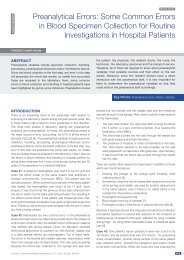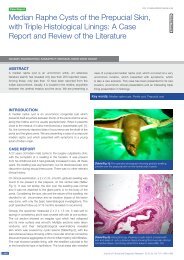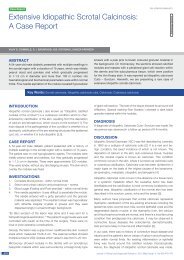A Study on Effects of Meditation on Sympathetic Nervous ... - JCDR
A Study on Effects of Meditation on Sympathetic Nervous ... - JCDR
A Study on Effects of Meditation on Sympathetic Nervous ... - JCDR
You also want an ePaper? Increase the reach of your titles
YUMPU automatically turns print PDFs into web optimized ePapers that Google loves.
ID: <strong>JCDR</strong>/2012/4293:2102<br />
A <str<strong>on</strong>g>Study</str<strong>on</strong>g> <strong>on</strong> <strong>Effects</strong> <strong>of</strong> Meditati<strong>on</strong><br />
<strong>on</strong> <strong>Sympathetic</strong> <strong>Nervous</strong> System<br />
Functi<strong>on</strong>al Status in Meditators<br />
Original Article<br />
Physiology Secti<strong>on</strong><br />
Desh Deepak, Anant Narayan Sinha, Vimal Singh Gusain, Ashish Goel<br />
ABSTRACT<br />
Objective: Meditati<strong>on</strong> has l<strong>on</strong>g been known to affect human<br />
physiology through aut<strong>on</strong>omic nervous system. This study was<br />
designed to assess sympathetic aut<strong>on</strong>omic functi<strong>on</strong>al status <strong>of</strong><br />
meditators <strong>of</strong> various age groups.<br />
Material and Methods: Three clinical tests, Isometric handgrip<br />
test,Cold pressor test and Valsalva Meneuver were studied in 25<br />
meditators <strong>of</strong> age ranging from 25 to 75 years. The results were<br />
compared with those observed in 25 n<strong>on</strong>-meditators <strong>of</strong> matching<br />
age and socio ec<strong>on</strong>omic status.<br />
Observati<strong>on</strong> and Results: The basal cardiac parameters viz<br />
heart rate and blood pressure were uniformly lower in meditators<br />
than n<strong>on</strong> meditators in all age groups, more so in senior<br />
meditators. On performing isometric handgrip test, n<strong>on</strong>-meditators<br />
developed significant increase in blood pressure and heart<br />
rate during gripping than that seen in meditators. In cold pressor<br />
test, as compared to n<strong>on</strong>-meditators, mediators showed blunted<br />
increase in blood pressure al<strong>on</strong>g with returning <strong>of</strong> blood pressure<br />
to basal level earlier, which indicated presence <strong>of</strong> c<strong>on</strong>trolled<br />
sympathetic drive in meditators. In Valsalva maneuver the overshoot<br />
<strong>of</strong> BP was lower in meditators than in n<strong>on</strong> meditators.<br />
C<strong>on</strong>clusi<strong>on</strong>: It can be c<strong>on</strong>cluded that the regular practice <strong>of</strong><br />
meditati<strong>on</strong> initially blunted the sympathetic drive and later <strong>on</strong><br />
developed c<strong>on</strong>trol over sympathetic functi<strong>on</strong> <strong>of</strong> meditators. .<br />
Key Words: Meditati<strong>on</strong> Cold Pressor test, Isometric Handgrip Dynamometry,<br />
Valsalva maneuver Meditators<br />
938<br />
INTRODUCTION<br />
A comm<strong>on</strong> essential feature <strong>of</strong> various spiritual traditi<strong>on</strong>s is the intuitive<br />
knowledge <strong>of</strong> close c<strong>on</strong>necti<strong>on</strong> between mind and the body,<br />
which may possibly be achieved by the techniques like Meditati<strong>on</strong>,<br />
Yoga etc. Meditati<strong>on</strong> is basically a family <strong>of</strong> many techniques, each<br />
<strong>of</strong> which is involved in the c<strong>on</strong>scious and voluntary efforts, to focus<br />
the attenti<strong>on</strong> <strong>of</strong> the meditator. It is an activity that keeps the attenti<strong>on</strong><br />
pleasantly anchored in the present moment. Meditati<strong>on</strong> has<br />
always been a subject <strong>of</strong> intense explorati<strong>on</strong> am<strong>on</strong>gst scientists.<br />
The physiology <strong>of</strong> meditati<strong>on</strong> differs from that <strong>of</strong> ordinary rest with<br />
eyes closed and from that <strong>of</strong> most hypnotic states. Further, during<br />
meditati<strong>on</strong>, deep physiological relaxati<strong>on</strong>, somewhat similar to<br />
that occurring in the “deepest” N<strong>on</strong>-Rapid-Eye-Movement (NREM)<br />
sleep phase occurs in a c<strong>on</strong>text <strong>of</strong> wakefulness [1,2].<br />
A vast complexity <strong>of</strong> biological organizati<strong>on</strong> indicates that the<br />
physiological resp<strong>on</strong>ses to meditati<strong>on</strong> probably occurs <strong>on</strong> a multidimensi<strong>on</strong>al,<br />
interactive basis. Further, meditati<strong>on</strong> produces specific<br />
neural activati<strong>on</strong> patterns involving decreased limbic arousal<br />
in the brain, which in turn results in reduced stress and increased<br />
aut<strong>on</strong>omic stability [3,4].Different clinical reflexes are practiced to<br />
assess aut<strong>on</strong>omic functi<strong>on</strong>s in clinical c<strong>on</strong>diti<strong>on</strong>s like borderline hypertensi<strong>on</strong><br />
and diabetes mellitus [5,6]. Some scientists have dem<strong>on</strong>strated<br />
the effects <strong>of</strong> meditati<strong>on</strong> <strong>on</strong> parameters like Galvanic<br />
Skin Resistance (GSR) and EDR <strong>on</strong>ly [2] but attempt to assess<br />
functi<strong>on</strong>ing <strong>of</strong> aut<strong>on</strong>omic nervous system in meditators by using<br />
different clinical reflexes are still lacking. So the present study was<br />
aimed to assess the aut<strong>on</strong>omic functi<strong>on</strong>al status in mediators by<br />
using such techniques.<br />
MATERIALS AND METHODS<br />
Present study was carried out in the department <strong>of</strong> Physiology,<br />
Himalayan Institute <strong>of</strong> Medical Sciences, Swami Ram Nagar, Dehra<br />
Dun, Uttaranchal, India. Out <strong>of</strong> fifty male subjects, 25-75 years <strong>of</strong><br />
age, who volunteered, twenty five were asymptomatic meditators<br />
(from Yogoda Satsanga Dhyana Mandali Dehradun) and rest twenty<br />
five were n<strong>on</strong>–meditators <strong>of</strong> similar age, and physical activity.<br />
From each meditator a detailed history <strong>of</strong> meditati<strong>on</strong> practices was<br />
recorded with special reference to durati<strong>on</strong>, numbers <strong>of</strong> meditati<strong>on</strong><br />
sessi<strong>on</strong>s per day, and the age at which the meditati<strong>on</strong> practice<br />
was started.<br />
Following clinical reflexes were performed to assess aut<strong>on</strong>omic<br />
functi<strong>on</strong>al status:<br />
1. Isometric hand grip Dynamometry [5]: On a sustained<br />
hand grip at 30% <strong>of</strong> maximum voluntary capacity for 15 sec,<br />
parameters i.e. Heart Rate (HR) and Blood Pressure (BP),<br />
were recorded just before the release <strong>of</strong> hand grip, after 1 min<br />
[Table/Fig-1]: Relative Rise in Blood Pressure <strong>on</strong> sustained Grip in N<strong>on</strong><br />
Meditators and Meditators<br />
Journal <strong>of</strong> Clinical and Diagnostic Research. 2012 August, Vol-6(6): 938-942
www.jcdr.net<br />
Desh Deepak et al., A <str<strong>on</strong>g>Study</str<strong>on</strong>g> <strong>on</strong> <strong>Effects</strong> <strong>of</strong> Meditati<strong>on</strong> <strong>on</strong> <strong>Sympathetic</strong> <strong>Nervous</strong> System in Meditators<br />
and 5 minutes <strong>of</strong> grip release.<br />
2. Cold Pressor test [7]: It was performed in sitting posture,<br />
while left hand (upto first crease at wrist) was immersed in<br />
cold water at 8 degree Celsius for 2 min. Parameters were<br />
recorded during immersi<strong>on</strong> and after 1and 5 minutes <strong>of</strong><br />
removing hand from cold water.<br />
3. Valsalva maneuver [7]: With nostrils closed and after forceful<br />
blow into the tube <strong>of</strong> aneroid manometer, subject held it at 40<br />
mmHg for 15 sec. RR intervals were observed to determine<br />
Valsalva Ratio. (Valsalva Ratio being the ratio <strong>of</strong> l<strong>on</strong>gest RR<br />
interval during 1 minute after the strain and shortest RR<br />
interval during the strain.)<br />
• Each test was performed after a resting period <strong>of</strong> 10<br />
minutes, in supine or sitting positi<strong>on</strong>.<br />
• The heart rate (HR) was measured from the R-R interval<br />
<strong>of</strong> ECG using Lead II <strong>of</strong> Electrocardiograph machine<br />
(BPL Cardiart 108). Blood Pressure was recorded by<br />
using an electr<strong>on</strong>ic BP apparatus (Nati<strong>on</strong>al, Japan).<br />
Handgrip strength was measured by using a handgrip<br />
Dynamometer.<br />
• The data obtained were subjected to appropriate statistical<br />
analysis using Micros<strong>of</strong>t Excel s<strong>of</strong>tware. The <strong>on</strong>e tail<br />
student ‘t’ test was applied for the analysis.<br />
Observati<strong>on</strong>s and Results<br />
All the subjects <strong>of</strong> both groups were divided into 3 groups <strong>of</strong> (25-<br />
40 years), (41-55 years) and (56 years <strong>on</strong>wards). Accordingly the<br />
n<strong>on</strong> meditators were groped as A,B,C and meditators as group<br />
D,E,F.<br />
The durati<strong>on</strong> <strong>of</strong> meditati<strong>on</strong> in years as well as in the hours per day<br />
was in direct proporti<strong>on</strong> to the increasing age <strong>of</strong> meditators.<br />
Basal Blood Pressure and Heart Rate: [Table/Fig-1]<br />
[Table/Fig-2]: Blood Pressure Changes during and after Cold Pressor Test<br />
[Table/Fig-3]: Blood Pressure Changes during and after Valsalva Maneuver<br />
N<strong>on</strong>-<br />
Meditators<br />
N<br />
(A+B+C) 25<br />
Mean Age<br />
± S D<br />
Mean SBP<br />
± S D<br />
Mean DBP<br />
± S D<br />
Mean H R<br />
± S D<br />
A 9 34.56 ± 4.42 118.33 ± 6.20 71.33 ± 3.43 69.77 ± 6.36<br />
B 9 47.33 ± 5.00 128 ± 10.55 84 ± 5.68 75.88 ± 12.92<br />
C 7 63.00 ± 7.21 135.42±10.06 79.85 ± 3.07 75 ± 9.20<br />
Meditators (D+E+F) 25<br />
Statistically Significant P values<br />
Intra Group<br />
N<strong>on</strong> Meditators<br />
D 9 36.67± 3.28 114.33 ± 6.20 68.33 ± 3.43 70.33 ± 9.49<br />
E 8 48.5 ± 5.88 115.9 ± 3.87 75.12 ± 5.59 70.75 ± 9.13<br />
F 8 67.5 ± 5.04 114.75 ± 4.09 71.88 ± 4.12 69.87 ± 8.90<br />
A vs B 0.006 0.073 0.080<br />
B vs C 0.001 0.087 0.043<br />
A vs C 0.001 0.002 0.001<br />
Intra Group<br />
Meditators<br />
D vs E 0.001 0.006<br />
E vs F 0.001<br />
D vs F 0.001 0.038<br />
Inter Group<br />
compariso<br />
A vs D 0.064 0.025<br />
B vs E 0.014 0.003<br />
C vs F 0.001 0.001<br />
[Table/Fig-4]: Age distri buti<strong>on</strong> and basal cardiac parameters <strong>of</strong> subjects<br />
Journal <strong>of</strong> Clinical and Diagnostic Research. 2012 August, Vol-6(6): 938-942 939
Desh Deepak et al., A <str<strong>on</strong>g>Study</str<strong>on</strong>g> <strong>on</strong> <strong>Effects</strong> <strong>of</strong> Meditati<strong>on</strong> <strong>on</strong> <strong>Sympathetic</strong> <strong>Nervous</strong> System in Meditators<br />
www.jcdr.net<br />
Age Group<br />
25-40<br />
Years<br />
Basal During Isometric Handgrip On release<br />
SBP DBP HR SBP DBP HR SBP DBP HR<br />
Group A Mean 120.0 66.0 69.1 123.0 79.6 74.4 121.2 75.9 68.4<br />
SD 2.96 5.77 7.79 6.00 6.53 13.00 7.01 7.57 9.36<br />
Group D Mean 116.0 62.8 66.9 119.8 72.1 80.0 115.8 67.4 72.4<br />
SD 1.67 2.17 11.08 4.53 4.10 20.29 4.60 9.77 11.41<br />
Unpaired ‘t’ test: A vs D 0.003 0.068 0.005 0.035 0.029<br />
Age Group<br />
41-55<br />
Years<br />
Group B Mean 125.8 83.2 76.8 131.1 90.3 71.8 122.3 82.9 77.7<br />
SD 9.04 5.14 13.26 16.01 6.80 22.73 15.72 6.51 16.09<br />
Group E Mean 115.1 73.5 68.8 125.5 76.5 78.1 109.0 64.3 68.8<br />
SD 10.59 6.91 8.12 9.71 8.45 15.67 12.14 25.18 8.10<br />
Unpaired ‘t’ test: B vs E 0.022 0.003 0.075 0.001 0.034 0.039 0.084<br />
Age Group<br />
56 Years<br />
Onwards<br />
Group C Mean 134.1 78.3 77.3 144.9 82.4 80.6 131.0 87.4 76.9<br />
SD 10.02 4.46 10.87 13.35 11.37 10.24 11.09 7.48 11.13<br />
Group F Mean 114.8 71.4 68.6 120.3 74.5 70.9 108.0 68.4 71.1<br />
SD 4.10 4.21 6.65 6.16 5.35 4.02 4.17 4.50 7.86<br />
Unpaired ‘t’ test: C vs F 0.001 0.005 0.049 0.001 0.064 0.024 0.001 0.001<br />
[Table/Fig-5]: Isometric Handgrip Dynamometry, P
www.jcdr.net<br />
Desh Deepak et al., A <str<strong>on</strong>g>Study</str<strong>on</strong>g> <strong>on</strong> <strong>Effects</strong> <strong>of</strong> Meditati<strong>on</strong> <strong>on</strong> <strong>Sympathetic</strong> <strong>Nervous</strong> System in Meditators<br />
Age<br />
Group<br />
25-40<br />
Years<br />
Basal Cold Pressor for 90 secs 1 Minute later 5 Minutes later<br />
SBP DBP HR SBP DBP HR SBP DBP HR SBP DBP HR<br />
Group A Mean 119.9 79.6 71.3 130.9 85.7 75.3 126.8 82.2 69.2 125.2 4.3 82.4 71.8<br />
SD 5.17 6.06 7.23 5.59 12.33 15.94 13.33 5.90 14.77 10.12 7.04 8.09<br />
Group D Mean 114.8 61.3 68.6 117.3 77.4 69.0 111.0 75.9 61.3 109.4 6.7 72.5 64.3<br />
SD 5.17 6.06 11.61 5.59 12.34 9.45 13.33 5.90 12.86 10.12 7.04 9.75<br />
Unpaired 't' test: A vs D 0.016 0.033 0.021 0.011 0.006 0.044 0.048<br />
Age<br />
Group<br />
41-55<br />
Years<br />
Group B Mean 121.6 84.9 77.1 142.3 97.4 83.1 123.0 84.7 76.7 124.6 12.5 90.2 75.3<br />
SD 13.85 4.81 12.22 7.02 7.54 13.41 12.04 6.30 11.86 20.90 9.23 5.81<br />
group E Mean 112.5 75.4 71.9 126.5 80.1 74.9 113.1 78.1 72.0 117.8 6.9 76.4 72.4<br />
SD 10.03 3.89 6.03 13.32 16.89 8.87 15.54 7.86 7.41 11.30 5.93 7.19<br />
Unpaired 't' test: B vs E 0.071 0.001 0.006 0.012 0.077 0.085 0.041 0.001<br />
Age<br />
Group<br />
56<br />
Years<br />
Group C Mean 139.6 77.4 75.7 142.3 86.6 77.9 137.0 84.0 75.3 138.0 3.0 83.6 76.4<br />
SD 15.08 5.94 7.87 19.34 9.20 8.97 18.18 7.30 8.36 18.27 7.02 7.89<br />
Group F Mean 106.0 68.8 69.3 117.0 66.6 69.4 106.5 69.0 70.3 106.4 9.1 67.4 69.0<br />
SD 5.21 4.89 6.86 4.00 6.86 4.03 7.11 4.63 7.23 5.01 3.78 4.66<br />
Unpaired 't' test: C vs F 0.001 0.005 0.059 0.007 0.001 0.025 0.002 0.001 0.002 0.000 0.028<br />
[Table/Fig-7]: P
Desh Deepak et al., A <str<strong>on</strong>g>Study</str<strong>on</strong>g> <strong>on</strong> <strong>Effects</strong> <strong>of</strong> Meditati<strong>on</strong> <strong>on</strong> <strong>Sympathetic</strong> <strong>Nervous</strong> System in Meditators<br />
www.jcdr.net<br />
lower in meditators than n<strong>on</strong>-meditators and especially so with<br />
l<strong>on</strong>g durati<strong>on</strong> practiti<strong>on</strong>ers.<br />
It can be c<strong>on</strong>cluded that meditative techniques may affect the aut<strong>on</strong>omic<br />
activity significantly creating a balance in favour <strong>of</strong> parasympathetic<br />
nervous system but the effects requires a l<strong>on</strong>g term<br />
c<strong>on</strong>tinuati<strong>on</strong> <strong>of</strong> the technique. Changes in aut<strong>on</strong>omic activity might<br />
help in reducing psychosomatic disorders and general well being<br />
<strong>of</strong> an individual.<br />
REFERENCES<br />
[1] Brown SW, Blodgett J. EEG Kappa rhythms during Transcendental<br />
meditati<strong>on</strong> and possible perceptual threshold changes. In: D Kanellakos<br />
editor. The Psychobiology <strong>of</strong> Transcendental meditati<strong>on</strong>: A Literature<br />
Review. Menlo Park (California): WA. Benjamin 1974.<br />
[2] Wallace RK, Bens<strong>on</strong> H, Wils<strong>on</strong> AF. A wakeful hypometabolic physiologic<br />
state. Am J Physiol 1971; 221: 795-99.<br />
[3] Jooyoung JS. The physiology <strong>of</strong> meditati<strong>on</strong> http:// www.dctkd.org/. 1997.<br />
[4] Schwartz G. Bi<strong>of</strong>eedback, self regulati<strong>on</strong> and the patterning <strong>of</strong> physiological<br />
processes. American Scientist 1975; 63: 314-24.<br />
[5] Mahajan SK, Mahajan KK, Gupta JP. Aut<strong>on</strong>omic reflexes in borderline<br />
hypertensives. JAPI 1990; 38:784 – 86.<br />
[6] Clarke BF, Ewing DJ, Campbell IW. Diabetic aut<strong>on</strong>omic neuropathy.<br />
Diabetologia 1979; 17: 195.<br />
[7] King MS, Carr T, DCruz C. Transcendental meditati<strong>on</strong>, hypertensi<strong>on</strong><br />
and heart disease. Aust Fam Physician 2002; 31:164-68.<br />
[8] Shapiro DH. Meditati<strong>on</strong>: Clinical and health related applicati<strong>on</strong>s. The<br />
Western J <strong>of</strong> Medicine1981; 134: 45.<br />
[9] Jevning R, Wallace RK, Beidebach M. A wakeful hypometabolic integrated<br />
resp<strong>on</strong>se. Neurosci Biobehav Rev 1992; 16: 415–24.<br />
[10] Patel C, Marmot MG, Terry DJ, Carruthers M, Hunt B, Patel M. Trial<br />
<strong>of</strong> relaxati<strong>on</strong> in reducing cor<strong>on</strong>ary risk: four year follow up. BMJ 1985;<br />
290: 1103-06.<br />
[11] Sarn<strong>of</strong>f SJ, Hardenbergh E, Whittenberger JL. Mechanism <strong>of</strong> arterial<br />
pressure resp<strong>on</strong>se to the Valsalva test. Am J Physiol 1948; 154: 316.<br />
[12] Wasir HS, Reybrouck T, Linjen P, Engard R, C<strong>on</strong>way J, Amery A. The<br />
effect <strong>of</strong> ageing <strong>on</strong> systolic arterial pressure and related variables in<br />
apparently normal subjects. In: Nathobhai and Padam Singhvi editors.<br />
Proceeding <strong>of</strong> the Internati<strong>on</strong>al C<strong>on</strong>gress <strong>on</strong> Hypertensi<strong>on</strong> Bombay:<br />
Hoecht 1977; 259.<br />
[13] Mark AL, Victor RG, Nerhed C, Wallin BG. Micr<strong>on</strong>eurographic studies<br />
<strong>of</strong> the mechanism <strong>of</strong> the sympathetic nerve resp<strong>on</strong>ses to static exercise<br />
in humans. Circ Res 1985; 57: 461-69.<br />
[14] Khurana RK, Setty A. The value <strong>of</strong> the isometric handgrip test – studies<br />
in various aut<strong>on</strong>omic disorders. Clin Aut<strong>on</strong> Res.1996; 6: 211-18.<br />
AUTHOR(S):<br />
1. Dr. Desh Deepak<br />
2. Dr. Anant Narayan Sinha<br />
3. Dr. Vimal Singh Gusain<br />
4. Dr. Ashish Goel<br />
PARTICULARS OF CONTRIBUTORS:<br />
1. Associate Pr<strong>of</strong>essor, Deptment <strong>of</strong> Physiology,<br />
VCSG Govt Medical Sciences and Research Institute,<br />
Srinagar, Uttarakhand, India.<br />
2. Assistant Pr<strong>of</strong>essor, Deptment <strong>of</strong> Physiology,<br />
VCSG Govt Medical Sciences and Research Institute,<br />
Srinagar, Uttarakhand, India.<br />
3 Assistant Pr<strong>of</strong>essor, Deptment <strong>of</strong> Physiology,<br />
VCSG Govt Medical Sciences and Research Institute,<br />
Srinagar, Uttarakhand, India.<br />
4 Assistant Pr<strong>of</strong>essor, Deptment <strong>of</strong> Physiology,<br />
SRMS Institute <strong>of</strong> Medical Sciences, Bareilly, UP, India.<br />
NAME, ADDRESS, TELEPHONE, E-MAIL ID OF THE<br />
CORRESPONDING AUTHOR:<br />
Dr. Desh Deepak<br />
Associate Pr<strong>of</strong>essor,Deptment <strong>of</strong> Physiology,<br />
VCSG Govt Medical Sciences and Research,<br />
Institute, Srinagar,Pin 246176 Uttarakhand, India.<br />
Ph<strong>on</strong>e: 9410932909<br />
E-mail: Deshdeepak_s@rediffmail.com<br />
Financial OR OTHER COMPETING INTERESTS:<br />
N<strong>on</strong>e.<br />
Date <strong>of</strong> Submissi<strong>on</strong>: Mar 17, 2012<br />
Date <strong>of</strong> Peer Review: Apr 01, 2012<br />
Date <strong>of</strong> Acceptance: Apr 18, 2012<br />
Date <strong>of</strong> Publishing: Aug 10, 2012<br />
942<br />
Journal <strong>of</strong> Clinical and Diagnostic Research. 2012 August, Vol-6(6): 938-942



